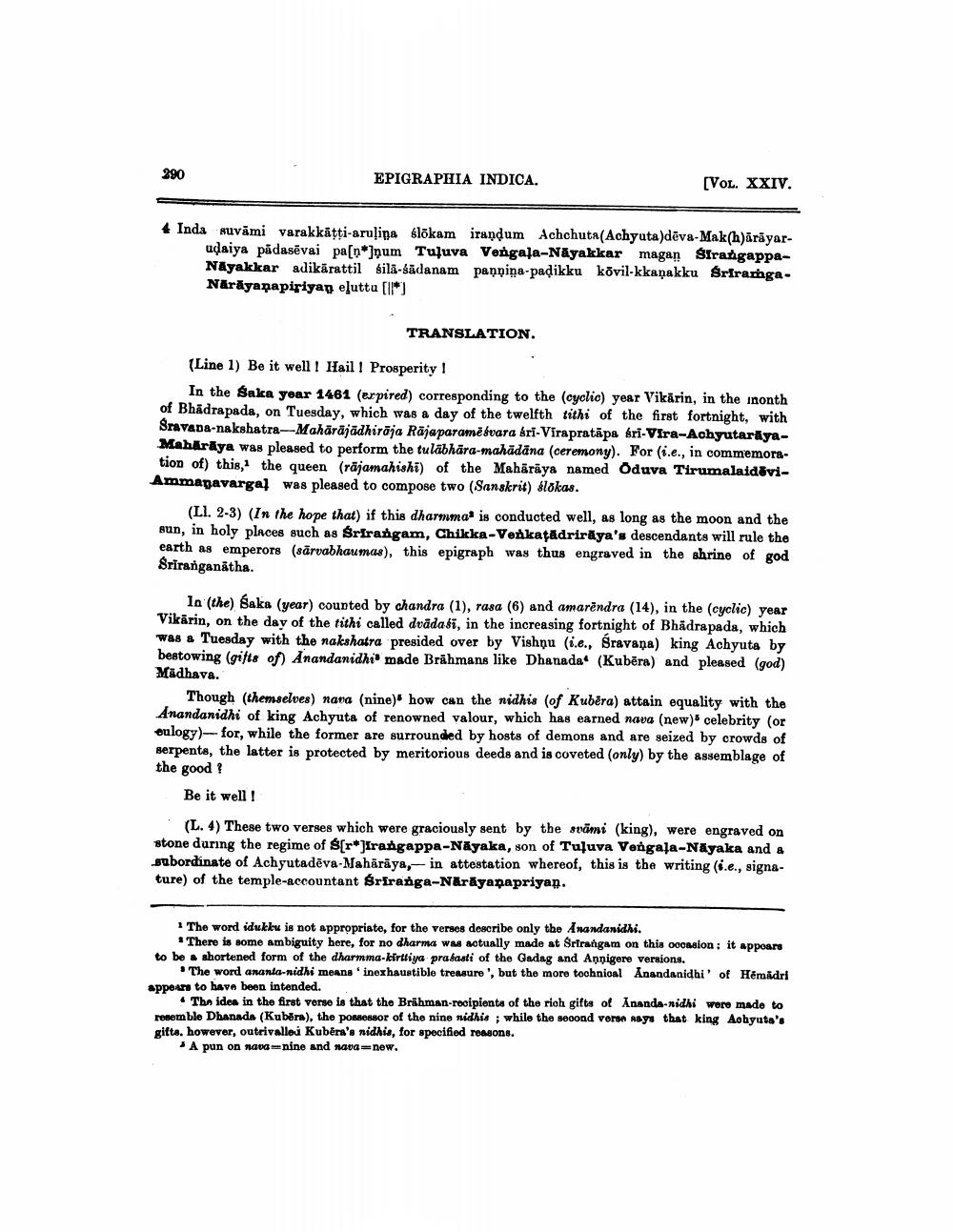________________
29.0
EPIGRAPHIA INDICA.
(VOL. XXIV.
4 Inda suvāmi varakkatti-aruļina blūkam irandum Achchuta(Achyuta)dēva-Mak(h)ārāyar
udaiya padasēvai pa[n]ņum Tuluva Vengala-Nāyakkar magan SirangappaNāyakkar adikärattil sila-sādanam panpina-padikku kõvil-kkaņakku SriramgaNārāyanapiriyar elutta [ll]
TRANSLATION.
(Line 1) Be it well I Hail ! Prosperity!
In the Saka year 1461 (erpired) corresponding to the (cyclic) year Vikärin, in the inonth of Bhādrapada, on Tuesday, which was a day of the twelfth tithi of the first fortnight, with Sravada-nakshatra--Mahäräjädhirāja Rajaparamē svara Sri-Virapratāpa Sri-Vira-AchyutarāyaMahārāya was pleased to perform the tulabhāra-mahädäna (ceremony). For (i.e., in commemora
tion of) this, the queen (rājamahishi) of the Mahäräya named Oduva TirumalaidoviAmma avargal was pleased to compose two (Sanskrit) slokas.
(Ll. 2-3) (In the hope that) if this dharmma is conducted well, as long as the moon and the sun, in holy places such as Srirangam, Chikka-Venkațädrirdya's descendants will rule the earth as emperors (sārvabhaumas), this epigraph was thus engraved in the shrine of god Sriranganátha.
ln (the) Saka (year) counted by chandra (1), rasa (6) and amarëndra (14), in the cyclic) year Vikärin, on the day of the tithi called dvadasi, in the increasing fortnight of Bhadrapada, which was a Tuesday with the nakshatra presided over by Vishnu (i.e., Sravana) king Achyuta by bestowing (gifts of) Anandanidhi made Brāhmans like Dhanada (Kubēra) and pleased (god)
Madhava.
Though themselves) nana (nine) how can the nidhis (of Kubera) attain equality with the Anandanidhi of king Achyuta of renowned valour, which has earned nava (new) celebrity (or eulogy)- for, while the former are surrounded by hosts of demons and are seized by crowds of serpents, the latter is protected by meritorious deeds and is coveted (only) by the assemblage of the good ?
Be it well!
(L. 4) These two verses which were graciously sent by the stāmi (king), were engraved on stone during the regime of $[r*Jirangappa-Nāyaka, son of Tuļuva Vengala-Nayaka and a subordinate of Achyutadēva-Mahārāya,- in attestation whereof, this is the writing (s.e., signature) of the temple-accountant Sriranga-Nārāyanapriyan.
1 The word idukku is not appropriate, for the verses describe only the Anandanidhi.
* There is some ambiguity bere, for no dharma wm actually made at Srirangam on this boonslon: it appoars to be a shortened form of the dharmma-kirttiya prasasti of the Gadag and Annigere versions.
The word ananta-nidhi means ' inexhaustible treasure, but the more toohnioal Anandanidhi' of Hemadri appears to have been intended.
• Thn idea in the first verse is that the Brihman-recipients of the rioh gifts of Ananda-nidhi were made to resemble Dhanada (Kubera), the possessor of the nine nidhis ; while the second veran Aay that king Achyuta's gitta, however, outrivallei Kubera's nidhis, for specified reasons.
SA pun on nava=nine and nava=new.




